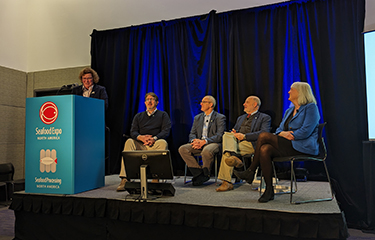s NOAA Fisheries continues to grapple with shifting fish populations due to warming waters, administration leaders are committed to making sure the regulatory solutions don’t leave coastal communities out to dry.
NOAA Fisheries Northeast Fisheries Science Center Science and Research Director Jon Hare speaking during a panel at Seafood Expo North America – running from 12 to 14 March in Boston, Massachusetts – said the ocean has clearly changed in the last several decades as certain species begin to expand their range.
“You can’t not catch black sea bass in Massachusetts,” Hare said during the panel. “I think that’s the example that I like to give. Black sea bass was historically mid Atlantic – sort of New Jersey to North Carolina species – in recent years the stock, the population has expanded northward.”
The language, Hare said, he used to describe the changes in the stock is important. Species aren’t so much as “shifting” their location, but are expanding in scope. Black sea bass can still be caught in its historical grounds in similar numbers, but now it is being found in places it never was before.
“So now black sea bass is available in Massachusetts, you can catch them up int the Gulf of Maine, but you still have them in the Mid Atlantic,” he said. “So how do you allow access to a new species in these more northern states, while the availability in the southern states are the same?”
That question is one the current regulatory structure for U.S. fisheries management, NOAA Greater Atlantic Regional Fisheries Office Regional Administrator Michael Pentony said, doesn’t have an answer to.
“John talks about the science and the science is obviously critical. It’s the root of everything we do. But you look at some of the management structures that we have in place that constrain our ability to be responsive and adapt, and black sea bass is a great example,” Pentony said.
The fishery management councils, he said, moved to a moratorium permit system 30 years ago, and those permits were based on the fisheries data that existed at the time – which itself is based on even older information.
“So we have permits that are effectively locked in place to a fishery as it existed decades ago, and as the stock expands, one of the challenges we have is how do we provide access to the fishing industry, the fishing communities, that now have an abundance of resources available to them, without detriment to the fishing communities and the fishing vessels?” Pentony said …
Photo by Chris Chase/SeafoodSource








